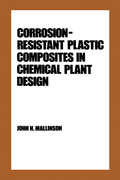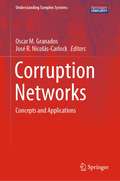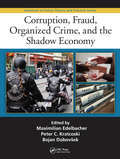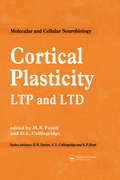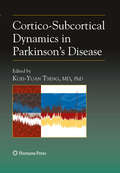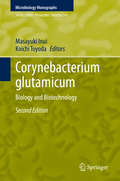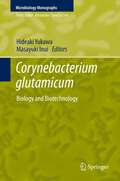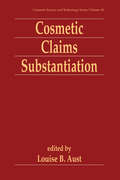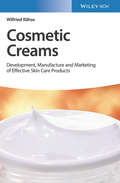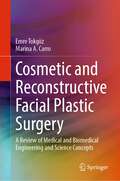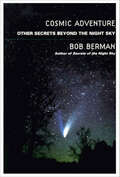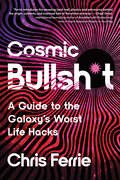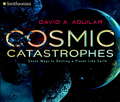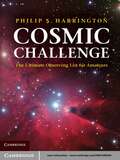- Table View
- List View
Corrosion of Reinforcement in Concrete (EFC 25): Monitoring, Prevention and Rehabilitation
by J. MietzThis book compiles the full papers presented in the successful session "Corrosion of Steel in Concrete" at EUROCORR '97. It highlights the areas of technical development in this field, including monitoring of steel reinforcement corrosion, prevention of corrosion and electrochemical repair methods.
Corrosion-Resistant Plastic Composites in Chemical Plant Design
by John H. MallinsonThis book covers piping, buried pipe, duct systems, recommendations for fire safety and smoke, abrasion resistance of fiberglass reinforced plastic (FRP), mechanism of FRP corrosion and deterioration, grounding of FRP systems, and popular fabrication methods of FRP.
Corrupted Science: Fraud, Ideology and Politics in Science (Revised & Expanded)
by John GrantA searing exposé of the misuses and misrepresentations of science from the time of Galileo continuing through to the present day, this new edition includes updates on the asbestos industry, the chemicals industry, the sugar industry, the agriculture industry (the abuse of antibiotics), and the automobile industry (lead in gasoline). The final chapter has been expanded to include the full-blooded assault on science mounted by the Trump administration.
Corruption Networks: Concepts and Applications (Understanding Complex Systems)
by Oscar M. Granados José R. Nicolás-CarlockThis book aims to gather the insight of leading experts on corruption and anti-corruption studies working at the scientific frontier of this phenomenon using the multidisciplinary tools of data and network science, in order to present current theoretical, empirical, and operational efforts being performed in order to curb this problem. The research results strengthen the importance of evidence-based approaches in the fight against corruption in all its forms, and foster the discussion about the best ways to convert the obtained knowledge into public policy.The contributed chapters provide comprehensive and multidisciplinary approaches to handle the non-trivial structural and dynamical aspects that characterize the modern social, economic, political and technological systems where corruption takes place.This book will serve a broad multi-disciplinary audience from natural to social scientists, applied mathematicians, including law and policymakers.
Corruption, Development and the Environment
by Lorenzo PellegriniThe book analyses the influence of corruption on economic growth and environmental protection, examining corruption from different perspectives. It contributes to several streams of the literature and assembles evidence of the influence of corruption on two important variables in human welfare: income and environmental policies. The material evinces the detrimental effect that corruption has on economic growth and on the stringency of environmental policies. It also shows that standard techniques for fighting corruption are often based either on simplistic definitions or on strong assumptions that do not apply in many countries blighted by corruption. From a methodological standpoint, this work combines a number of approaches including a theoretical discussion of corruption and of its definition (often omitted in economic studies), together with econometrics, case studies and policy discussions.
Corruption, Fraud, Organized Crime, and the Shadow Economy (Advances in Police Theory and Practice)
by Peter C. Kratcoski Maximilian Edelbacher Bojan DobovšekFueled by corruption, fraud, and organized crime, the shadow economy also known as the informal, black market, illegal, or underground economy is currently on the rise worldwide. Corruption, Fraud, Organized Crime, and the Shadow Economy addresses shadow economies and the players involved by examining various aspects of criminal law and prosecution
Cortical Areas: Unity and Diversity (Conceptual Advances In Brain Research Ser.)
by Robert Miller Almut SchüzThe study of areas in the cerebral cortex has a long history, bringing empirical data into close relation with fundamental conceptual issues about the cortex. The subject is currently being revitalized with the advent of new experimental methods and this book brings a modern perspective to the study of these areas. Cortical Areas: Unity and Diversi
Cortical Plasticity
by Sam Fazeli Graham L. CollingridgeThis book provides an insight into the rapidly growing field of cortical plasticity. It brings together diverse experimental approaches to the study of activity-dependent changes in neuronal connections, as exemplified by long-term potentiation (LTP) and long-term depression (LTD).
Cortical Spreading Depression of Leao: From Mitochondrial Function to Brain Metabolic Score (BMS)
by Avraham Mayevsky Judith SonnThis book focuses on energy metabolism and brain functions related to Cortical Spreading Depression of Leao (CSD), an important issue in brain pathophysiology. The first part of the book offers a comprehensive overview of the history and early research on CSD, and then discusses the recent advances in the technology used to map and monitor brain mitochondrial NADH redox state and other physiological functions during CSD. The chapters explore the connection between CSD and mitochondrial function under hypoxia, Ischemia and various drugs treatment, and provide a resource to scientists researching the development of CSD during various brain pathophysiological conditions. This book is essential to scientists and students working in the field of bioenergetics of the brain and various organs and tissues in the body. The use of this technology is also crucial and applicable in the neuroscience field.
Cortico-Subcortical Dynamics in Parkinson’s Disease (Contemporary Neuroscience)
by Kuei-Yuan TsengWhile much currently remains unknown in the field of Parkinson's research, this book assembles all that is currently known about the pathophysiological changes underlying Parkinson's Disease (PD). It aims to integrate key aspects of current PD knowledge and research, specifically how disruptions of the non dopamine systems resulting from chronic dopaminergic degeneration could lead to the functional alterations observed in parkinsonism. The understanding of these mechanisms interactions and a proper analysis of the input-output transformations within the cortico-basal ganglia circuitry will contribute to the unveiling of important dynamic features of information processing in the PD brain.
Corticotropin-Releasing Factor: Basic and Clinical Studies of a Neuropeptide
by Errol B. De SouzaThis book provides a comprehensive summary of data from basic and clinical studies in support of a role for corticotropin-releasing factor (CRF) as a neurotransmitter in the mammalian central nervous system (CNS). It includes descriptions of the anatomy of CRF and its receptors in the CNS, as well as the characterization of CRF receptors and the second messenger systems mediating effects of CRF in the brain. It discusses the autonomic, behavioral, and electrophysiologic effects of CRF administration in the brain. This work also includes a section which covers the role of brain CRF in the etiology and pathophysiology of a variety of neurologic, psychiatric, and endocrine disorders. Endocrinologists, brain researchers, and neuroendocrinologists are among those who will find this reference both useful and interesting.
Corynebacterium diphtheriae and Related Toxigenic Species: Genomics, Pathogenicity and Applications
by Andreas BurkovskiCorynebacterium diphtheriae is the classical etiological agent of diphtheria and the type strain of the genus Corynebacterium. While diphtheria of the respiratory tract became rare with the introduction of vaccination programs in industrialized countries, even today several thousand cases per year are reported to the World Health Organization. This shows that diphtheria is not completely eradicated and that reservoirs exist. The book summarizes the latest advances made in understanding C. diphtheriae and the closely related species Corynebacterium ulcerans and Corynebacterium pseudotuberculosis. Topics addressed are genomics of toxigenic corynebacteria, host-pathogen-interaction, detection, surveillance and treatment as well as application aspects.
Corynebacterium glutamicum: Biology and Biotechnology (Microbiology Monographs #23)
by Masayuki Inui Koichi ToyodaThis updated second edition covers the molecular biology, genome engineering tools and comprehensive analysis techniques for Corynebacterium glutamicum. Aside from modern omics-based approaches, the authors also focus on cell physiology, including cell division, central carbon metabolic pathways, and the respiratory chain. Readers will learn how primary mechanisms like energy metabolism can be applied in processes like biorefinery. Newly added topics include cell envelope structures and aromatic compound metabolism in C. glutamicum. These chapters will be particularly useful for those interested in the microbial production of commodity chemicals, fuels, and proteins. Corynebacteriacea are already some of the most important industrial microorganisms. Understanding the cell physiology of C. glutamicum will help manufacturers to increase their product range and productivity through efficient metabolic engineering.
Corynebacterium glutamicum: Biology and Biotechnology (Microbiology Monographs #23)
by Masayuki Inui Nami TatsumiCorynebacterium glutamicum was discovered in Japan in 1956 as a natural glutamate producer. Its "microbial factory" qualities, such as its physiological plasticity and robust catalytic functionalities, have since facilitated the development of efficient production processes for amino acids, nucleotides and vitamins. This monograph illustrates how the information gleaned from complete genome sequencing allows the rational engineering of the entire cellular metabolism and how systems biology permits the further optimization of C. glutamicum as a biocatalyst. Aspects of gene regulation, metabolic pathways, sugar uptake, protein secretion, cell division and biorefinery applications highlight the enormous biotechnological and biorefinery potential.
Cosmetic Claims Substantiation
by Louise AustShows how to validate scientifically the marketing claims of chemically stable and well-balanced products to withstand adequately the challenge of competitors and government regulators. The book describes techniques for substantiating properties, such as moisturization, mildness, conditioning and cleansing, as well as the performance of deodorants
Cosmetic Creams: Development, Manufacture and Marketing of Effective Skin Care Products
by Wilfried RähseA guide to cosmetic creams that focuses on formulation, production, and safety concerns Cosmetic Creams: Development, Manufacture and Marketing of Effective Skin Care Products puts the focus on the structure and formulation of a cosmetic cream, the production process, the effect of each ingredient, as well as safety considerations. Comprehensive in scope, the book contains a basic definition of cosmetics and describes the types of skin creams currently on the market, the major ingredients used, and example compositions. The author, Wilfried Rähse?a noted expert on the topic?offers guidelines for estimating manufacturing costs and includes procedures for an effective safety assessment. The book contains information on various aspects of skin penetration and production and covers issues like materials used and hygienic packaging. In addition, Rähse reviews legal regulations with an emphasis on the European market. He discusses GMP and EHEDG directives. This important book: -Offers a comprehensive resource that explores all aspects of cosmetic cream manufacturing and marketing -Provides valuable guidelines for practitioners in the field -Covers the underlying technologies of cosmetic creams -Includes a review of raw material and manufacturing costs, hygiene and safety, and legal regulations -Written by an author with more than 30 years? experience in the industry Written for cosmetic chemists, chemists in industry, chemical engineers, dermatologists, Cosmetic Creams: Development, Manufacture and Marketing of Effective Skin Care Products, offers a unique industrial perspective of the topic that is comprehensive in scope.
Cosmetic Formulation: Principles and Practice
by Heather A.E. Benson Michael S. Roberts Vania Rodrigues Leite-Silva Kenneth WaltersCosmetics are the most widely applied products to the skin and include creams, lotions, gels, and sprays. Their formulation, design, and manufacturing ranges from large cosmetic houses to small private companies. This book covers the current science in the formulations of cosmetics applied to the skin. It includes basic formulation, skin science, advanced formulation, and cosmetic product development, including both descriptive and mechanistic content with an emphasis on practical aspects.
Cosmetic Microbiology: A Practical Approach
by Philip A. GeisCosmetics are unique products, as diverse as foods and drugs, but without the imposed limits of shelf-life considerations and sterile manufacturing. Furthermore, unlike foods and drugs, the cosmetic industry lacks the support of established academic programs or a significant body of publication; instead, its knowledge base has always fallen under t
Cosmetic and Reconstructive Facial Plastic Surgery: A Review of Medical and Biomedical Engineering and Science Concepts
by Emre Tokgöz Marina A. CarroCosmetic and Reconstructive Facial Plastic Surgery: Medical and Biomedical Engineering and Science Concepts provides an extensive overview of the most recent technological advancements in facial plastic and reconstructive surgeries and head and neck surgery through a thorough review of the literature in biomedical engineering, technology, and medicine. Coverage includes the most recent engineering and computing techniques, such as robotics, biomechanics, artificial intelligence (AI), deep learning (DL), machine learning (ML), and optimization, as well as the medical and surgical aspects of medical and scientific methods, surgical and non-surgical procedure types, complications, patient care, and psychological factors. This book will be a valuable introduction to concepts and advances for otorhinolaryngology, biomedical researchers, academics, and students.
Cosmic Adventure: Other Secrets Beyond the Night Sky
by Bob BermanHave you ever wondered what happened before the Big Bang, or how we would colonize Mars, or what an alien invasion might really be like? Astronomer Bob Berman has, and in Cosmic Adventure, a collection of twenty-six profound to outrageous essays, he takes readers on a mind-bending tour of the universe, including our own planet Earth. From the most extraordinary cosmic phenomena to the basics of the natural world, Berman challenges us to look at the facts, discoveries, concepts, and awesome wonders of our cosmos in a new light. Written in entertaining, jargon-free language that even a novice stargazer will understand, Cosmic Adventure is a fun-filled, thought-provoking exploration of the secrets beyond the night sky.Bob Berman takes you on a stellar journey in this collection of essays that display a lively mix of science, astounding facts, personal anecdotes, and sheer playfulness. Complex, mind-stretching scientific topics become understandable in human terms as Berman links astronomy to our lives. He explores strange new mysteries raised by recent discoveries, and covers areas that haven't been discussed anywhere else before. From the "night terrors" that have haunted humankind since time immemorial to the penniless eccentric who sleeps inside the revolutionary telescope he designed, Berman's scope ranges far and wide.Cosmic Adventure explains aspects of the physical world that have often piqued our curiosity. Who gets to name the stars? What would an alien invasion really be like? What's the inside story behind space program disasters? Why was the early Hubble goof avoidable? What's the only original idea in recent science? Why does time probably not exist at all?
Cosmic Apprentice: Dispatches from the Edges of Science
by Dorion SaganIn the pursuit of knowledge, Dorion Sagan argues in this dazzlingly eclectic, rigorously crafted, and deliciously witty collection of essays, scientific authoritarianism and philosophical obscurantism are equally formidable obstacles to discovery. As science has become more specialized and more costly, its questing spirit has been constrained by dogma. And philosophy, perhaps the discipline best placed to question orthodoxy, has retreated behind dense theoretical language and arcane topics of learning.Guided by a capacious, democratic view of science inspired by the examples set by his late parents—Carl Sagan, who popularized the study of the cosmos, and Lynn Margulis, an evolutionary biologist who repeatedly clashed with the scientific establishment—Sagan draws on classical and contemporary philosophy to intervene provocatively in often-charged debates on thermodynamics, linear and nonlinear time, purpose, ethics, the links between language and psychedelic drugs, the search for extraterrestrial intelligence, and the occupation of the human body by microbial others. Informed by a countercultural sensibility, a deep engagement with speculative thought, and a hardheaded scientific skepticism, he advances controversial positions on such seemingly sacrosanct subjects as evolution and entropy. At the same time, he creatively considers a wide range of thinkers, from Socrates to Bataille and Descartes to von Uexküll, to reflect on sex, biopolitics, and the free will of Kermit the Frog. Refreshingly nonconformist and polemically incisive, Cosmic Apprentice challenges readers to reject both dogma and cliché and instead recover the intellectual spirit of adventure that should—and can once again—animate both science and philosophy.
Cosmic Bullsh*t: A Guide to the Galaxy's Worst Life Hacks
by Chris FerrieA hilarious guide to what's real (and what's not) in our vast, beautiful (and terrifying) universe.Embark on a cosmic journey through Cosmic Bullsh*t: A Guide to the Galaxy's Worst Life Hacks and uncover the real science behind some of the greatest lies society loves to tell us! Apologies to everyone who makes major life decisions based on their newspaper horoscope, but astrology isn't real and stars and planets don't give a sh*t about us. Planning a vacation to Roswell to finally discover the truth about aliens that the government has been hiding? Bad news—aliens were never here, and they aren't coming, either. Put on your myth-busting goggles and dig into Cosmic Bullsh*t for a nice, healthy dose of fascinating facts to cure the misinformation sickness so many of us are suffering from. Quantum physicist and bestselling science author Chris Ferrie explains:Why creation myths are bullsh*t and why humans have loved them for millennia anywayThe misconceptions surrounding extraterrestrial life and why little green men aren't knocking on our door (spoiler alert: it's not because they're shy)The paradoxes and pitfalls of time travelHow to brace yourself for the ultimate cosmic finale as we contemplate the fate of the universeAnd much more!With Cosmic Bullsh*t, you'll laugh, you'll learn, and you'll never look at the universe the same way again. So buckle up, fellow space travelers, and prepare to have your minds blown by the weirdest, wildest, and most wondrous aspects of the cosmos.
Cosmic Catastrophes
by J. Craig WheelerFrom supernovae and gamma-ray bursts to the accelerating Universe, this is an exploration of the intellectual threads that lead to some of the most exciting ideas in modern astrophysics and cosmology. This fully updated second edition incorporates new material on binary stars, black holes, gamma-ray bursts, worm-holes, quantum gravity and string theory. It covers the origins of stars and their evolution, the mechanisms responsible for supernovae, and their progeny, neutron stars and black holes. It examines the theoretical ideas behind black holes and their manifestation in observational astronomy and presents neutron stars in all their variety known today. This book also covers the physics of the twentieth century, discussing quantum theory and Einstein's gravity, how these two theories collide, and the prospects for their reconciliation in the twenty-first century. This will be essential reading for undergraduate students in astronomy and astrophysics, and an excellent, accessible introduction for a wider audience.
Cosmic Catastrophes: Seven Ways to Destroy a Planet Like Earth
by David AguilarIn the vast realm of outer space, accidents happen all the time. Things bump into each other. Stars blow up. Space rocks smash into planets. Black holes gobble up everything in their path. The sun is burning out. A comet swarm is bearing down. Any of this could change--or even eliminate--life on a planet like Earth. Countdown to cosmic catastrophes! From asteroid hit to alien invasion, astronomer David Aguilar builds the scientific case for seven extreme events that could impact Earth. (Though not as we know it: most of these catastrophes are way down the cosmic line . . . we hope!) He tells an exciting nonfiction story about how and why these space catastrophes could happen and then creates beautiful, original art to show just how devastatingly spectacular it will be when any one of these seven "big ones" hit! The SMITHSONIAN INSTITUION is the world's largest museum and research complex. Founded in 1846, it includes nineteen museum and galleries, the National Zoological Park, and nine research facilities. Its vast collections house 138 million artifacts, specimens, and works of art, which represent our nation's rich heritage, art from across the globe, and the immense diversity of the natural and cultural world.
Cosmic Challenge: The Ultimate Observing List For Amateurs
by Philip S. HarringtonListing more than 500 sky targets, both near and far, in 187 challenges, this observing guide will test novice astronomers and advanced veterans alike. Its unique mix of Solar System and deep-sky targets will have observers hunting for the Apollo lunar landing sites, searching for satellites orbiting the outermost planets, and exploring hundreds of star clusters, nebulae, distant galaxies, and quasars. Each target object is accompanied by a rating indicating how difficult the object is to find, an in-depth visual description, an illustration showing how the object realistically looks, and a detailed finder chart to help you find each challenge quickly and effectively. The guide introduces objects often overlooked in other observing guides and features targets visible in a variety of conditions, from the inner city to the dark countryside. Challenges are provided for the naked eye, through binoculars and the largest backyard telescopes.

